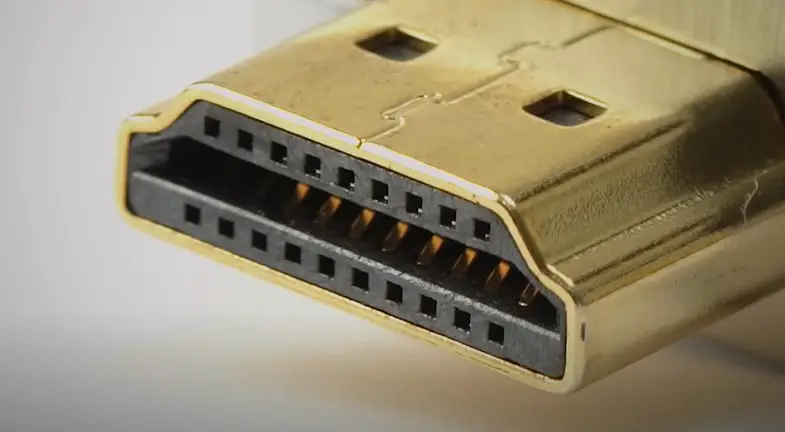So, you have brought this new soundbar to your home theater and are now ready to connect it to your TV. However, as you look at the back of the TV and soundbar, you see two different types of ports for connection: TOSLINK (Digital Optical) and HDMI.
Now, you may find yourself in a quagmire from which you can’t escape until you make the correct choice.
Don’t wait for a fairy godmother to magically appear to help you decide; she is from ancient times and knows nothing about home theater tech, HDMI, or Optical. Instead of waiting for her, continue to read for about ten minutes to resolve the mystery of connecting the soundbar to the TV.
Let’s get started!
What is HDMI?

You might never have appreciated an audio/video connection before, but HDMI deserves a moment of your attention. HDMI (High-definition Multimedia Interface) is like the unsung hero of home entertainment, as it processes high-quality audio and video connections through a single connection.
This godsend digital interface supports and transmits high-quality audio and video signals, including 4K, 8K, and 10K videos and advanced audio formats like Dolby Digital, Dolby Atmos, and DTS:X.
Furthermore, High-end HDMI connections like HDMI ARC and eARC provide an audio return channel that reduces the wire cluster by transmitting the audio and video channels back and forth through a single HDMI cable. It also comes with a CEC feature (Consumers Electronics Control) which lets the user control multiple devices with a single remote.
What is Digital Optical?

Now let’s get to know the old Diva of the communication channels; Digital optical. It’s an old audio transmitter and can be seen in most old TVs. It was developed in 1983 and transmits audio as light signals. Furthermore, the cables are made of fiber optics. The digital optical connection can provide up to 5.1 channels of audio, and it also supports it was audio formats such as Dolby Digital and DTS.
Although HDMI is used in modern TV and soundbars; however digital optical is still a good option for quality audio and video transmission.
Now that you know about HDMI and digital optical, you might want to know which connection is better in your case. So let’s dive into a quick comparison between the two audio connections and find the best one.
Showdown of the Super Powers: HDMI VS Optical
Now let’s get back to where we started!
You are stuck between the two Divas: HDMI and Optical; which one to choose for the soundbar? Here’s a quick comparison between the two that will help make your decision easier.
Material:
HDMI cables are made of Copper, which is widely used for wire manufacturing. However, this material is prone to electromagnetic interference. On the contrary, the digital optical connection uses light for signal transmission, which is completely safe from any type of electromagnetic interference.
Audio quality:
Who doesn’t want their home theater booming with the most immersive sound experience?
Everyone does! At the end, it’s audio and video quality that we care about, which is why you must know the better option for an undefeatable audio quality in your home theater.
Digital Optical can provide high-quality audio up to 5.1 channels, including Dolby Digital (which is lossy). However, because optical cables have limited bandwidth and are somewhat outdated, they can’t support newer high-end audio formats.
On the other hand, HDMI is capable of much more than you might imagine!
HDMI ARC and eARC are known to be the Undefeated titans for delivering high-quality audio and video signals. It can take the audio game upto 7.1 channels of uncompressed audio, and high-end audio formats Dolby True HD, DTS:X, DTS-HD Master Audio (lossless), Dolby Digital, and Dolby digital plus (lossy). So, HDMI stands alone as winner in this case for the amazing audio and video signal transmission.
Reduced wire clutter:
Again, HDMI is the mess cleaner here, whereas digital optical stands as the bad boy who creates mess all over your home theater.
HDMI allows the transmission of audio and video signals through the same connection and in case of ARC and eARC: it comes with an audio return channel which magically reduces the number of wires in your home theater.
With this Audio return channel, all you need to do is to plug in all the external devices into your TV and then use a single HDMI cable to connect the HDMI ARC port on your TV to one on the soundbar, and VOILA!
Now, what will it do?
It will take all the video signals from the external devices and send them to the TV. Over the same channel, it will separate the audio signals and send them to the soundbar.
Isn’t it amazing?
Now, Digital Optical is not capable of providing an audio return channel; for this, you’ll need to use a separate audio cable to connect the external devices to the soundbar, increasing wire clutter.
Bandwidth:
The newer tech is always better than the previous one; which is why digital optical has shorter bandwidth as compared to the new generation: HDMI!
HDMI has a higher bandwidth of up to 48Gbps with the latest cables, such as HDMI 2.1. This allows all the seamless transmission of high-quality audio and video formats of higher bandwidth.
In contrast, Digital Optical has a maximum bandwidth of 1.5Mbps, which pales in comparison.
Single remote control:
The cool kid takes the lead in this one too!
HDMI as in its ARC and eARC connection comes with a cool CEC feature (Consumer Electronic Control) which allows the user to control multiple devices with a single remote. Now, this is something the old grandpa can’t do at all.
So, HDMI for the Win Win!
Let’s Connect the soundbar to TV!
Now, that you have reached this far, you must have successfully decided the connection that you want for connecting your TV to the soundbar. If your TV supports both digital and HDMI connection, without even a second thought, go for HDMI connection.
For HDMI stands undefeated for its countless features, audio quality, higher bandwidth, and two-way transmission.
So, grab a high-quality HDMI cable and experience immersive audio and video in your home theater.

I’m Shaun Conroy, an audiophile & founder of HiFi Audios. Holding a Bachelor’s in Sound Engineering, I bring deep expertise in audio devices and offer insights & recommendations to fellow enthusiasts.





